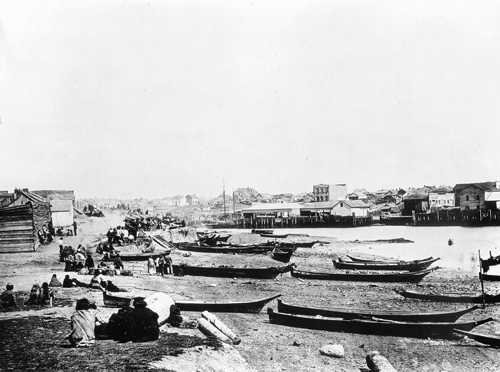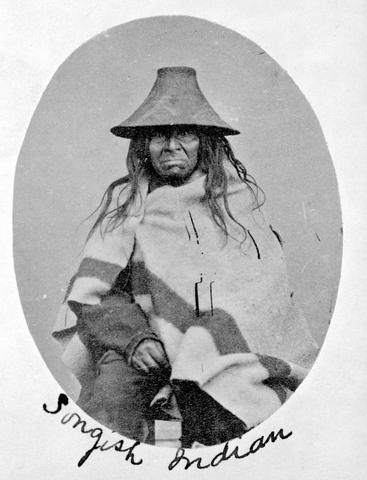Songhees on:
[Wikipedia]
[Google]
[Amazon]
The Lekwungen peoples (natively lək̓ʷəŋən) are a Coast Salish people who reside on southeastern
 There is evidence of a fortified village existing at Finlayson Point in Beacon Hill Park before the arrival of Europeans. Before European contact much of the government was through a clan system, with twelve clans which each had its own fishing and hunting territory. Chiefship was hereditary in the male line and there were three castes - nobles, commons, and slaves. Like other north-west coast tribes they practiced
There is evidence of a fortified village existing at Finlayson Point in Beacon Hill Park before the arrival of Europeans. Before European contact much of the government was through a clan system, with twelve clans which each had its own fishing and hunting territory. Chiefship was hereditary in the male line and there were three castes - nobles, commons, and slaves. Like other north-west coast tribes they practiced 
Songhees Nation website
Esquimalt Nation website
{{authority control Coast Salish First Nations in British Columbia Victoria, British Columbia
Vancouver Island
Vancouver Island is an island in the northeastern Pacific Ocean and part of the Canadian province of British Columbia. The island is in length, in width at its widest point, and in total area, while are of land. The island is the largest ...
, British Columbia
British Columbia is the westernmost Provinces and territories of Canada, province of Canada. Situated in the Pacific Northwest between the Pacific Ocean and the Rocky Mountains, the province has a diverse geography, with rugged landscapes that ...
in the Greater Victoria
Greater Victoria (also known as the Greater Victoria Region) is located in British Columbia, Canada, on the southern tip of Vancouver Island. It is usually defined as the thirteen municipalities of the Capital Regional District (CRD) on V ...
area. They are represented by the Songhees and Esquimalt First Nations. Their traditional language is Lekwungen
The Lekwungen peoples (natively lək̓ʷəŋən) are a Coast Salish people who reside on southeastern Vancouver Island, British Columbia in the Greater Victoria area. They are represented by the Songhees First Nation, Songhees and Esquimalt First ...
, a dialect of the North Straits Salish language.
Name
The term "Lekwungen" is a contemporary designation used to describe a group of Indigenous peoples who speak the Lekwungen language. It refers specifically to six families historically residing on southern Vancouver Island, in the area now known asGreater Victoria
Greater Victoria (also known as the Greater Victoria Region) is located in British Columbia, Canada, on the southern tip of Vancouver Island. It is usually defined as the thirteen municipalities of the Capital Regional District (CRD) on V ...
.
The people associated with this term have also been referred to as the Songhees or Songish, although the latter designation is now primarily used to refer to the Songhees Band government. This term was an Anglicization of an ethnonymn to describe a group living between Albert Head and Esquimalt Lagoon.
History
Pre-contact
The traditional territory of the Lekwungen encompasses most of what is now the Greater Victoria area, as well as the nearbyDiscovery
Discovery may refer to:
* Discovery (observation), observing or finding something unknown
* Discovery (fiction), a character's learning something unknown
* Discovery (law), a process in courts of law relating to evidence
Discovery, The Discovery ...
, Chatham, and San Juan islands
The San Juan Islands is an archipelago in the Pacific Northwest of the United States between the U.S. state of Washington and Vancouver Island, British Columbia, Canada. The San Juan Islands are part of Washington state, and form the core of ...
. Their territory was divided between six families: Kayaakan, Teechamitsa, Whyomilth, Kosampsom, Swngwhung, and Chekonein. There is evidence of a fortified village existing at Finlayson Point in Beacon Hill Park before the arrival of Europeans. Before European contact much of the government was through a clan system, with twelve clans which each had its own fishing and hunting territory. Chiefship was hereditary in the male line and there were three castes - nobles, commons, and slaves. Like other north-west coast tribes they practiced
There is evidence of a fortified village existing at Finlayson Point in Beacon Hill Park before the arrival of Europeans. Before European contact much of the government was through a clan system, with twelve clans which each had its own fishing and hunting territory. Chiefship was hereditary in the male line and there were three castes - nobles, commons, and slaves. Like other north-west coast tribes they practiced potlatch
A potlatch is a gift-giving feast practiced by Indigenous peoples of the Pacific Northwest Coast of Canada and the United States,Harkin, Michael E., 2001, Potlatch in Anthropology, International Encyclopedia of the Social and Behavioral Scienc ...
and ceremonial gift distribution. The dead were buried in canoes or boxes upon the surface of the ground, or laid away in trees. Mentioning the names of a dead person was taboo
A taboo is a social group's ban, prohibition or avoidance of something (usually an utterance or behavior) based on the group's sense that it is excessively repulsive, offensive, sacred or allowed only for certain people.''Encyclopædia Britannica ...
. The Coast Salish traditionally lived in bighouses, large rectangular communal houses of cedar planks, adorned with carved and jointed totem posts.

Sitchanalth
A majorCoast Salish
The Coast Salish peoples are a group of ethnically and linguistically related Indigenous peoples of the Pacific Northwest Coast, living in the Canadian province of British Columbia and the U.S. states of Washington and Oregon. They speak on ...
seaport community called Sitchanalth was located in the area now known as Willows Beach in Oak Bay, British Columbia. It is estimated that the village's peak population was around 10,000 people.
Sitchanalth was destroyed by a tsunami
A tsunami ( ; from , ) is a series of waves in a water body caused by the displacement of a large volume of water, generally in an ocean or a large lake. Earthquakes, volcanic eruptions and underwater explosions (including detonations, ...
related to a major earthquake along the Devils Mountain Fault that occurred around 930 A.D. The death toll from the earthquake and resulting tsunami have been described as "catastrophic" with a small group of survivors relocating from Willows Beach to what is now the Inner Harbour area of Victoria, British Columbia
Victoria is the capital city of the Provinces and territories of Canada, Canadian province of British Columbia, on the southern tip of Vancouver Island off Canada's Pacific Ocean, Pacific coast. The city has a population of 91,867, and the Gre ...
.
A cairn at Willows Beach marks the spot where the ancient settlement once stood.
Colonization
The Lekwungen population was estimated to be 8,500 in 1859, but by 1914 the population had decreased to less than 200. At the time of the establishment of Fort Victoria by the British in 1843, a Lekwungen village was situated adjacent to the fort. The village was subsequently moved across Victoria Harbour in what is now the Victoria West neighbourhood. The village was subsequently moved and a reserve established adjacent to what is now the municipality of View Royal. A traditional blessing in Lekwungen appears on a mural on the Ogden Point breakwater. During the 1862 Pacific Northwest smallpox epidemic, which killed about two-thirds of all native people in British Columbia, the Lekwungen were largely spared due tosmallpox vaccine
The smallpox vaccine is used to prevent smallpox infection caused by the variola virus. It is the first vaccine to have been developed against a contagious disease. In 1796, British physician Edward Jenner demonstrated that an infection with th ...
s given by Hudson's Bay Company physician Dr. John Helmcken, as well as Lekwungen self-quarantining on Discovery Island. Due to these things the Lekwungen survived the epidemic with few deaths.
Douglas Treaties
The Lekwungen were one of the few First Nations in BC to have a treaty with the British. Sir James Douglas, governor of the Vancouver Island colony, negotiated a treaty with the Lekwungen in 1850. Recently the Lekwungen considered that the government of British Columbia had failed to honour the 1850 treaty and commenced a legal action against the province and theGovernment of Canada
The Government of Canada (), formally His Majesty's Government (), is the body responsible for the federation, federal administration of Canada. The term ''Government of Canada'' refers specifically to the executive, which includes Minister of t ...
for redress. A settlement of the action was announced in November 2006 by Songhees Chief Robert Sam, the federal Minister of Indian Affairs and Northern Development, Jim Prentice
Peter Eric James Prentice (July 20, 1956 – October 13, 2016) was a Canadian politician who served as the 16th premier of Alberta from 2014 to 2015. In the 2004 federal election he was elected to the House of Commons of Canada as a candida ...
, and the provincial Minister of Aboriginal Relations and Reconciliation, Mike de Jong.
Esquimalt First Nation
They were signatories to the Douglas Treaties as the ''Kosapsum''. x̣ʷiméɫǝɫ (Esquimalt) is the term which was originally used to describe the specific location of a group of Songhees people living near the mouth of the Mill Stream at the head of present-day Esquimalt Harbour. x̣ʷiméɫǝɫ was translated by J.W. McKay during the negotiation of the Douglas treaties as meaning “a place of gradually shoaling”. Over time, the term “Esquimalt” came to be applied more generally to the harbour area and to a group of people living at the village known as Kalla, located on the northern shore of Plumper Bay (archaeological site DcRu-36). The contemporary Esquimalt Nation comprises descendants of the signatories of the Kosapsum Treaty, rather than the original group of individuals after whom the name originated. This latter group signed a distinct treaty known as the Whyomilth (Esquimalt) Treaty.See also
*Songhees First Nation
The Songhees First Nation is one of two First Nations governments that represents the Lekwungen people (the other being Esquimalt First Nation). They are located around Victoria, British Columbia on southern Vancouver Island, British Columbia, C ...
* Esquimalt First Nation
References
External links
Songhees Nation website
Esquimalt Nation website
{{authority control Coast Salish First Nations in British Columbia Victoria, British Columbia